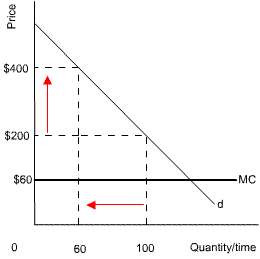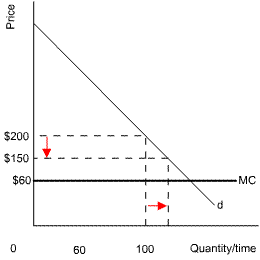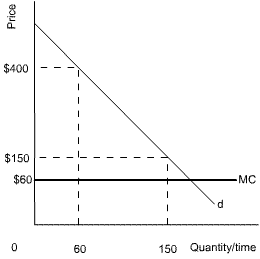- CFA Exams
- 2023 Level I > Topic 2. Economics > Reading 9. The Firm and Market Structures
- 6. Price Discrimination
Why should I choose AnalystNotes?
Simply put: AnalystNotes offers the best value and the best product available to help you pass your exams.
Subject 6. Price Discrimination
- In first-degree price discrimination each consumer is charged the maximum he is willing to pay. Consumer surplus is nil, while producer surplus is maximized. The output is the same as in a competitive market.
- In second-degree price discrimination, prices vary across units but not people. Consumers self-select into consumption groups and seek the largest surplus.
- In third-degree price discrimination, consumers are segregated by demographic or other traits. Prices are determined by the demands of each group.
When sellers can segment their market (at a low cost) into groups with differing price elasticities of demand, price discrimination can increase profits. For each group, the seller will maximize profit by equating marginal cost and marginal revenue. The number of units sold also increases because the discounts provided to price-sensitive groups increase the quantity sold more than the higher prices charged the less price-sensitive groups reduce sales.
Imagine that the MC per unit for a monopoly is constant at $60, producing a horizontal MC curve, as shown below.

The firm produces where MC = MR. It thus produces 100 units and charges $200 per unit. Total revenue (price x quantity) for the firm is thus: $200 x 100 = $20,000. Total costs (cost per unit x quantity) are: $60 x 100 = $6,000. Total profit is thus: $20,000 - $6,000 = $14,000.
Imagine that this firm is an airline and that it now decides to increase its profits using price discrimination. It identifies two groups of people: businessmen, who are fairly price-inelastic, and students, who are fairly price-elastic (responsive to changes in price). By increasing the price of businessmen's tickets and decreasing the price of student's tickets, it can increase its total revenue and thus increase its profit.
The airline starts by doubling the price of businessmen's tickets to $400. By equating the businessmen's MR curve to the MC curve (for simplicity, the MR curve is not shown), the airline finds that the quantity demanded decreases, but by relatively little, given the large increase in price, to 60 tickets.

Next, it equates MC to the students' MR curve and finds that it can decrease the price of students' tickets from $200 to $150, whilst the quantity demanded increases to 150 tickets. (Note: for simplicity, the students' MR curve is not shown).

Therefore, the total revenue is as follows: $400 x 60 + $150 x 150 = $46,500.
Total costs are: $60 x 60 + $60 x 150 = $12,600.
Total profits are thus: $46,500 - $12,600 = $33,900.
This is more than the $14,000 profit the firm made in the absence of price discrimination.

Practice Question 1
Sellers may gain from price discrimination by charging ______.I. higher prices to groups of customers with more inelastic demand
II. higher prices to groups of customers with more elastic demand
III. lower prices to groups of customers with more inelastic demand
IV. lower prices to groups of customers with more elastic demandCorrect Answer: I and IV
Practice Question 2
Which of the following products or services are examples where price discrimination occurs?I. Higher education tuition
II. Airline tickets
III. Movie tickets
IV. Health careCorrect Answer: All of the above
Practice Question 3
With perfect price discrimination, the market demand curve becomes the ______.A. average revenue curve
B. marginal revenue curve
C. marginal cost curveCorrect Answer: B
Practice Question 4
Which of the following is not an example of price discrimination?A. A ballpark that charges lower ticket prices for children under 5 years old
B. A discount offered to students on the purchase of a new computer
C. A store-wide sale at your local department store
D. A dentist who offers a range of prices based upon his patients' income
E. An "early bird" special at a restaurantCorrect Answer: C
The department store sale does not differentiate between consumers, eliminating the possibility of price discrimination.
Practice Question 5
Which of the following is true about price discrimination?I. Price discrimination increases firm profits.
II. Price discrimination benefits some consumers.
III. The price-discriminating firm will charge a higher price to the group with more inelastic demand.
IV. Price discrimination harms some consumers.Correct Answer: I, II, III and IV
Price discrimination increases firm profits, benefits the group that is charged the lower price, and harms the more inelastic group, which is charged a higher price.
Practice Question 6
Price discrimination is more common for services, such as viewing a movie, than for goods, such as computers. How can we explain this?A. It is not profitable to offer discounts on computers.
B. Firms that sell computers do not have market power, but movie theaters do.
C. It is difficult to prevent resale of computers but easy to prevent resale of movies viewed.
D. Everyone has the same willingness to pay for a computer.
E. It is illegal to price discriminate in the computer market.Correct Answer: C
For effective price discrimination, it must be possible to prevent resale. It is difficult to prevent the resale of goods such as computers.
Practice Question 7
True or False? Price discrimination refers to paying unequal wages to workers based on gender.Correct Answer: FalsePractice Question 8
A price-discriminating monopolist will charge the lowest price to the group with the ______.A. most elastic demand
B. most inelastic demand
C. most people in it
D. least people in it
E. greatest willingness to payCorrect Answer: A
A price-discriminating monopolist will charge the lowest price to those with the most elastic demand and raise the price to the group with less elastic demand.
Practice Question 9
Which of the following statements is correct? In the United States ______A. it is illegal to practice price discrimination and/or price fixing.
B. it is illegal to practice price discrimination but not price fixing.
C. it is illegal to practice price fixing but not price discrimination.
D. both price fixing and price discrimination are legal.Correct Answer: C
Price fixing is illegal but price discrimination is not.
Practice Question 10
When a price-discriminating monopolist offers a senior discount, its total profit is likely to be ______.A. lower than the total profit obtained from a single-price policy
B. higher than the total profit obtained from a single-price policy
C. the same as the total profit obtained from a single-price policyCorrect Answer: B
Price discrimination results in higher profit.
Practice Question 11
Which practice(s) is (are) price discrimination?I. Meals in New York City cost more than meals in a small town.
II. Airline tickets are extremely expensive if you purchase them at the last minute.Correct Answer: II
Practice Question 12
The more perfectly a monopoly can price discriminate, ______A. the farther its output gets from the competitive output and the less efficient is the outcome.
B. the farther its output gets from the competitive output and the more efficient is the outcome.
C. the closer its output gets to the competitive output and the more efficient is the outcome.Correct Answer: C
The more perfectly a monopoly can price discriminate, the closer its output gets to the competitive output (P = MC) and the more efficient is the outcome.
Practice Question 13
An airline initially has a single price of $200 for all consumers. At this price, it sells 400 business tickets and 700 tourist tickets. The airline's marginal cost is $50. The slope of the business demand curve is 2.0 (in absolute value) and the slope of the tourist demand curve is 0.1 (in absolute value). How can the airline increase its profits, assuming that it can separate the market and prevent resale?A. Charge a higher price to tourists and a lower price to business customers.
B. Charge a lower price to tourists and a higher price to business customers.
C. Charge the same price to business customers and a lower price to tourists.Correct Answer: B
Business: MR = 200 - (2*400) = -600 < MC. Tourist: MR = 200 - (.1 * 700) = 130 > MC. The airline should increase the price to business customers and reduce the price to tourists.
Practice Question 14
Which of the following is an example of price discrimination?A. Meals in New York City cost more than meals in a small town.
B. The grocery store has a "buy one, get one free" sale on eggs.
C. The local department store has special sale prices that are only good from 8 a.m. to 11 a.m.Correct Answer: C
Only the early morning sale is a price-discrimination scheme. Meals cost more in cities because firm costs are higher. The egg sale is available to everyone.
Practice Question 15
Which of the following is NOT a price discrimination scheme?A. Paperback and hardback books sell at prices that are much different than the difference in their production costs.
B. Strawberries cost more in the winter than in the summer.
C. You can save $1 on a product if you clip a coupon out of the newspaper and take it to the store. Correct Answer: B
Strawberries are less expensive in the summer because supply is much greater then.
Practice Question 16
Price discrimination is the practice of ______A. dividing consumers into two or more groups and charging different prices to each group.
B. dividing market demand among producers who will charge the same prices to consumers.
C. discriminating against consumers on the basis of race, sex, religion, or national origin.Correct Answer: A
Price discrimination consists of dividing consumers into groups and charging prices based on willingness or ability to pay.
Practice Question 17
Price discrimination is most likely an attempt by a monopoly to ______A. capture a consumer surplus.
B. resell a product.
C. capture a producer surplus.Correct Answer: A
A monopoly employs price discrimination to capture consumer surplus and to convert a consumer surplus to an economic profit.

Study notes from a previous year's CFA exam:
6. Price Discrimination